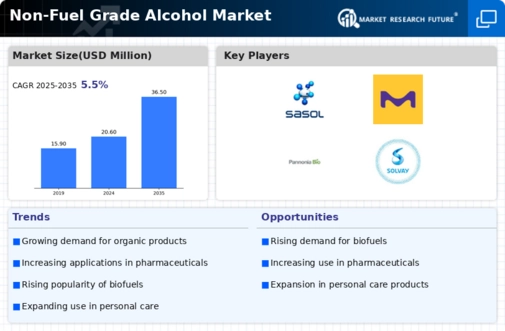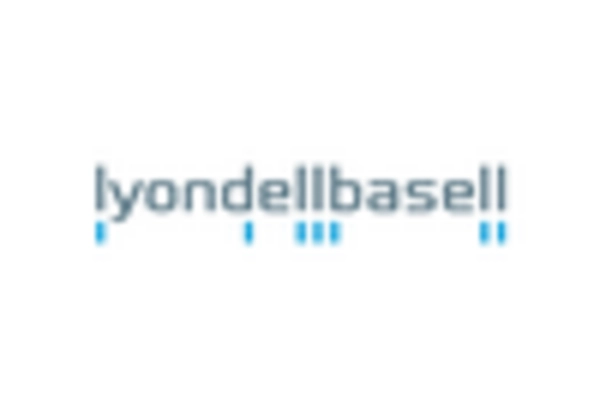-
EXECUTIVE SUMMARY
-
GLOBAL NON-FUEL
-
GRADE ALCOHOL MARKET, BY type
-
GLOBAL NON-FUEL GRADE ALCOHOL MARKET, BY Application
-
GLOBAL NON-FUEL
-
GRADE ALCOHOL MARKET analysis, BY Region
-
MARKET INTRODUCTION
-
DEFINITION
-
Scope of the Study
-
MARKET STRUCTURE
-
RESEARCH METHODOLOGY
-
RESEARCH PROCESS
-
PRIMARY RESEARCH
-
SECONDARY RESEARCH
-
MARKET SIZE ESTIMATION
-
FORECAST MODEL
-
List of Assumptions
-
market dynamics
-
introduction
-
Drivers
- Increasing use of Non-Fuel Grade Alcohol in
-
food & beverages industry
-
restraints
- raw material prices hampering the market growth
-
opportunities
- Rising Demand in the Pharmaceuticals
-
and Personal Care Industries
-
cHALLENGES
- adverse effects of non-fuel grade alcohol
-
MARKET FACTOR ANALYSIS
-
SUPPLY CHAIN ANALYSIS
- Raw Materials Suppliers
- NON-FUEL GRADE ALCOHOL Manufacturers
- Distribution Channels
- Application
-
PORTER’S FIVE
- Threat of Substitutes
- Bargaining Power of Buyers
- Intensity of Rivalry
-
FORCES MODEL
-
Threat of New Entrants
-
Bargaining Power of Suppliers
-
Pricing analysis by Region, USD/Ton, 2019-2021
-
Impact of Covid-19
- Impact on Supply Chain on Global Non-Fuel Grade
-
on the global market for Non-Fuel Grade Alcohol
-
Alcohol Market
-
GLOBAL NON-FUEL GRADE ALCOHOL MARKET, BY TYPE
-
OVERVIEW
- NON-FUEL GRADE ALCOHOL: MARKET ESTIMATES &
- NON-FUEL GRADE ALCOHOL: MARKET ESTIMATES & FORECAST BY TYPE,
-
FORECAST BY TYPE, 2019–2030
-
Food Grade
-
FOOD GRADE: MARKET ESTIMATES & FORECAST BY region,2019–2030
-
Pharmaceutical Grade
- PHARMACEUTICAL
-
GRADE: MARKET ESTIMATES & FORECAST BY region,2019–2030
-
Lab Grade
- LAB GRADE: MARKET ESTIMATES
-
& FORECAST BY region,2019–2030
-
Industrial Grade
- Industrial Grade: MARKET ESTIMATES & FORECAST
-
BY region,2019–2030
-
OTHERS
- OTHERS: MARKET ESTIMATES & FORECAST BY region,2019–2030
-
GLOBAL NON-FUEL GRADE
-
ALCOHOL MARKET, BY APPLICATION
-
OVERVIEW
- NON-FUEL GRADE ALCOHOL: MARKET ESTIMATES & FORECAST BY APPLICATION,
-
NON-FUEL GRADE ALCOHOL: MARKET ESTIMATES & FORECAST BY APPLICATION, 2019–2030
-
FOOD & BEVERAGES
-
PHARMACEUTICALS
- PHARMACEUTICALS:
-
MARKET ESTIMATES & FORECAST BY region,2019–2030
-
COSMETICS & PERSONAL CARE
-
CHEMICAL SOLVENT
-
others
-
global NON-FUEL GRADE
-
ALCOHOL MARKET by type in application
-
OVERVIEW
- NON-FUEL GRADE ALCOHOL: MARKET ESTIMATES & FORECAST
- NON-FUEL GRADE ALCOHOL: MARKET ESTIMATES & FORECAST BY type
-
BY type in APPLICATION, 2019-2030
-
in APPLICATION, 2019–2030
-
GLOBAL NON-FUEL GRADE ALCOHOL MARKET, BY REGION
-
OVERVIEW
-
NORTH AMERICA
- US
- canada
-
europe
- germany
- france
- Italy
- Spain and Portugal
- UK and Ireland
- Austria and Switzerland
- Benelux
- Nordics (Sweden, Norway, Denmark)
- central and eastern
- GCC Countries
- South Africa
- Rest of Middle East & Africa
-
europe
-
southern Europe
-
asia-pacific
-
China
-
India
-
Japan
-
South Korea
-
Rest of Asia-Pacific
-
Latin America
-
Brazil
-
Mexico
-
Argentina
-
Rest of Latin America
-
Middle East & Africa
-
COMPETITIVE LANDSCAPE
-
introduction
-
Global Market Strategy Analysis
-
COMPETITIVE BENCHMARKING
-
KEY DEVELOPMENTS
- COMPANY OVERVIEW
- FINANCIAL OVERVIEW
- PRODUCTS OFFERed
- KEY DEVELOPMENTS
- SWOT ANALYSIS
- KEY STRATEGIES
-
and GROWTH STRATEGIES
-
RECOGNITION
-
Acquisition
-
COMPANY PROFILES
-
Archer Daniels Midland Company
-
Cargill, Incorporated
- COMPANY OVERVIEW
- FINANCIAL OVERVIEW
- PRODUCTS OFFERed
- KEY DEVELOPMENTS
- SWOT ANALYSIS
- KEY STRATEGIES
-
Sasol
- COMPANY OVERVIEW
- FINANCIAL OVERVIEW
- PRODUCTS OFFERed
- KEY DEVELOPMENTS
- SWOT ANALYSIS
- KEY STRATEGIES
-
Merck KGaA
- COMPANY OVERVIEW
- FINANCIAL OVERVIEW
- PRODUCTS OFFERed
- KEY DEVELOPMENTS
- SWOT ANALYSIS
- KEY STRATEGIES
-
CropEnergies AG
- COMPANY OVERVIEW
- FINANCIAL OVERVIEW
- PRODUCTS OFFERed
- KEY DEVELOPMENTS
- SWOT ANALYSIS
- KEY STRATEGIES
-
LyondellBasell Industries Holdings BV
- COMPANY OVERVIEW
- FINANCIAL OVERVIEW
- PRODUCTS OFFERed
- KEY DEVELOPMENTS
- SWOT ANALYSIS
- KEY STRATEGIES
-
Pannonia Bio
- COMPANY OVERVIEW
- FINANCIAL OVERVIEW
- PRODUCTS OFFERed
- KEY DEVELOPMENTS
- SWOT ANALYSIS
- KEY STRATEGIES
-
Wilmar Sugar Pty
-
Ltd.
-
COMPANY OVERVIEW
-
FINANCIAL OVERVIEW
-
PRODUCTS OFFERed
-
KEY DEVELOPMENTS
-
SWOT ANALYSIS
-
KEY STRATEGIES
-
Godavari Biorefineries Ltd
-
COMPANY OVERVIEW
-
FINANCIAL OVERVIEW
-
PRODUCTS OFFERed
-
KEY DEVELOPMENTS
-
SWOT ANALYSIS
-
KEY STRATEGIES
-
Solvay
- COMPANY OVERVIEW
- FINANCIAL OVERVIEW
- PRODUCTS OFFERed
- KEY DEVELOPMENTS
- SWOT ANALYSIS
- KEY STRATEGIES
-
APPENDIX
-
REFERENCES
-
RELATED REPORTS
-
-
LIST OF TABLES
-
LIST OF ASSUMPTIONS
-
NON-FUEL GRADE ALCOHOL MARKET ESTIMATES &
-
FORECAST, BY TYPE, 2019–2030 (USD MILLION)
-
NON-FUEL GRADE ALCOHOL MARKET ESTIMATES &
-
FORECAST, BY TYPE, 2019–2030 (KILOTONS)
-
FOOD GRADE MARKET ESTIMATES & FORECAST,
-
BY REGION, 2019–2030 (USD MILLION)
-
FOOD GRADE MARKET ESTIMATES & FORECAST, BY REGION,
-
PHARMACEUTICAL GRADE MARKET ESTIMATES & FORECAST, BY REGION,
-
PHARMACEUTICAL GRADE MARKET ESTIMATES & FORECAST, BY REGION,
-
LAB GRADE MARKET ESTIMATES & FORECAST, BY REGION, 2019–2030
-
(USD MILLION)
-
TABLE
-
LAB GRADE MARKET ESTIMATES & FORECAST, BY REGION, 2019–2030 (KILOTONS)
-
INDUSTRIAL GRADE
-
MARKET ESTIMATES & FORECAST, BY REGION, 2019–2030 (USD MILLION)
-
INDUSTRIAL GRADE
-
MARKET ESTIMATES & FORECAST, BY REGION, 2019–2030 (KILOTONS)
-
OTHERS MARKET
-
ESTIMATES & FORECAST, BY REGION, 2019–2030 (USD MILLION)
-
OTHERS MARKET ESTIMATES
-
& FORECAST, BY REGION, 2019–2030 (KILOTONS)
-
NON-FUEL GRADE ALCOHOL MARKET ESTIMATES
-
& FORECAST, BY APPLICATION, 2019–2030 (USD MILLION)
-
NON-FUEL GRADE ALCOHOL
-
MARKET ESTIMATES & FORECAST, BY APPLICATION, 2019–2030 (KILOTONS)
-
FOOD & BEVERAGES
-
MARKET ESTIMATES & FORECAST, BY REGION, 2019–2030 (USD MILLION)
-
FOOD & BEVERAGES
-
MARKET ESTIMATES & FORECAST, BY REGION, 2019–2030 (KILOTONS)
-
PHARMACEUTICALS
-
MARKET ESTIMATES & FORECAST, BY REGION, 2019–2030 (USD MILLION)
-
PHARMACEUTICALS
-
MARKET ESTIMATES & FORECAST, BY REGION, 2019–2030 (KILOTONS)
-
COSMETICS &
-
PERSONAL CARE MARKET ESTIMATES & FORECAST, BY REGION, 2019–2030 (USD MILLION)
-
COSMETICS &
-
PERSONAL CARE MARKET ESTIMATES & FORECAST, BY REGION, 2019–2030 (KILOTONS)
-
CHEMICAL SOLVENT
-
MARKET ESTIMATES & FORECAST, BY REGION, 2019–2030 (USD MILLION)
-
CHEMICAL SOLVENT
-
MARKET ESTIMATES & FORECAST, BY REGION, 2019–2030 (KILOTONS)
-
OTHERS MARKET
-
ESTIMATES & FORECAST, BY REGION, 2019–2030 (USD MILLION)
-
OTHERS MARKET ESTIMATES
-
& FORECAST, BY REGION, 2019–2030 (KILOTONS)
-
NON-FUEL GRADE ALCOHOL MARKET ESTIMATES
-
& FORECAST, BY TYPE IN APPLICATION, 2019–2030 (USD MILLION)
-
NON-FUEL GRADE
-
ALCOHOL MARKET ESTIMATES & FORECAST, BY TYPE IN APPLICATION, 2019–2030
-
(KILOTONS)
-
TABLE
-
GLOBAL NON-FUEL GRADE ALCOHOL MARKET, BY REGION, 2019–2030 (USD MILLION)
-
GLOBAL NON-FUEL
-
GRADE ALCOHOL MARKET, BY REGION, 2019–2030 (KILOTONS)
-
NORTH AMERICA: NON-FUEL GRADE ALCOHOL MARKET,
-
BY COUNTRY, 2019–2030 (USD MILLION)
-
NORTH AMERICA: NON-FUEL GRADE ALCOHOL MARKET,
-
BY COUNTRY, 2019–2030 (KILOTONS)
-
NORTH AMERICA: NON-FUEL GRADE ALCOHOL MARKET, BY
-
TYPE, 2019–2030 (USD MILLION)
-
NORTH AMERICA: NON-FUEL GRADE ALCOHOL MARKET, BY
-
TYPE, 2019–2030 (KILOTONS)
-
NORTH AMERICA: NON-FUEL GRADE ALCOHOL MARKET, BY APPLICATION,
-
NORTH AMERICA: NON-FUEL GRADE ALCOHOL MARKET, BY APPLICATION,
-
NORTH AMERICA: NON-FUEL GRADE ALCOHOL MARKET, BY TYPE IN APPLICATION,
-
NORTH AMERICA: NON-FUEL GRADE ALCOHOL MARKET, BY TYPE IN APPLICATION,
-
US: NON-FUEL GRADE ALCOHOL MARKET, BY TYPE, 2019–2030
-
(USD MILLION)
-
TABLE
-
US: NON-FUEL GRADE ALCOHOL MARKET, BY TYPE, 2019–2030 (KILOTONS)
-
US: NON-FUEL
-
GRADE ALCOHOL MARKET, BY APPLICATION, 2019–2030 (USD MILLION)
-
US: NON-FUEL GRADE ALCOHOL
-
MARKET, BY APPLICATION, 2019–2030 (KILOTONS)
-
US: NON-FUEL GRADE ALCOHOL MARKET, BY TYPE
-
IN APPLICATION, 2019–2030 (USD MILLION)
-
US: NON-FUEL GRADE ALCOHOL MARKET, BY TYPE
-
IN APPLICATION, 2019–2030 (KILOTONS
-
CANADA: NON-FUEL GRADE ALCOHOL MARKET, BY
-
TYPE, 2019–2030 (USD MILLION)
-
CANADA: NON-FUEL GRADE ALCOHOL MARKET, BY TYPE,
-
CANADA:: NON-FUEL GRADE ALCOHOL MARKET, BY APPLICATION, 2019–2030
-
(USD MILLION)
-
TABLE
-
CANADA: NON-FUEL GRADE ALCOHOL MARKET, BY APPLICATION, 2019–2030 (KILOTONS)
-
CANADA: NON-FUEL
-
GRADE ALCOHOL MARKET, BY TYPE IN APPLICATION, 2019–2030 (USD MILLION)
-
CANADA: NON-FUEL
-
GRADE ALCOHOL MARKET, BY TYPE IN APPLICATION, 2019–2030 (KILOTONS
-
EUROPE: NON-FUEL
-
GRADE ALCOHOL MARKET, BY COUNTRY, 2019–2030 (USD MILLION)
-
EUROPE: NON-FUEL GRADE
-
ALCOHOL MARKET, BY COUNTRY, 2019–2030 (KILOTONS)
-
EUROPE: NON-FUEL GRADE ALCOHOL MARKET, BY
-
TYPE, 2019–2030 (USD MILLION)
-
EUROPE: NON-FUEL GRADE ALCOHOL MARKET, BY TYPE,
-
EUROPE: NON-FUEL GRADE ALCOHOL MARKET, BY APPLICATION, 2019–2030
-
(USD MILLION)
-
TABLE
-
EUROPE: NON-FUEL GRADE ALCOHOL MARKET, BY APPLICATION, 2019–2030 (KILOTONS)
-
EUROPE: NON-FUEL
-
GRADE ALCOHOL MARKET, BY TYPE IN APPLICATION, 2019–2030 (USD MILLION)
-
EUROPE: NON-FUEL
-
GRADE ALCOHOL MARKET, BY TYPE IN APPLICATION, 2019–2030 (KILOTONS
-
GERMANY: NON-FUEL
-
GRADE ALCOHOL MARKET, BY TYPE, 2019–2030 (USD MILLION)
-
GERMANY: NON-FUEL GRADE ALCOHOL MARKET,
-
BY TYPE, 2019–2030 (KILOTONS)
-
GERMANY: NON-FUEL GRADE ALCOHOL MARKET, BY APPLICATION,
-
GERMANY: NON-FUEL GRADE ALCOHOL MARKET, BY APPLICATION, 2019–2030
-
(KILOTONS)
-
TABLE
-
GERMANY: NON-FUEL GRADE ALCOHOL MARKET, BY TYPE IN APPLICATION, 2019–2030
-
(USD MILLION)
-
TABLE
-
GERMANY: NON-FUEL GRADE ALCOHOL MARKET, BY TYPE IN APPLICATION, 2019–2030
-
(KILOTONS
-
TABLE
-
FRANCE: NON-FUEL GRADE ALCOHOL MARKET, BY TYPE, 2019–2030 (USD MILLION)
-
FRANCE: NON-FUEL
-
GRADE ALCOHOL MARKET, BY TYPE, 2019–2030 (KILOTONS)
-
FRANCE: NON-FUEL GRADE ALCOHOL MARKET, BY
-
APPLICATION, 2019–2030 (USD MILLION)
-
FRANCE: NON-FUEL GRADE ALCOHOL MARKET, BY
-
APPLICATION, 2019–2030 (KILOTONS)
-
FRANCE: NON-FUEL GRADE ALCOHOL MARKET, BY TYPE
-
IN APPLICATION, 2019–2030 (USD MILLION)
-
FRANCE: NON-FUEL GRADE ALCOHOL MARKET, BY
-
TYPE IN APPLICATION, 2019–2030 (KILOTONS
-
ITALY: NON-FUEL GRADE ALCOHOL MARKET, BY
-
TYPE, 2019–2030 (USD MILLION)
-
ITALY: NON-FUEL GRADE ALCOHOL MARKET, BY TYPE,
-
ITALY: NON-FUEL GRADE ALCOHOL MARKET, BY APPLICATION, 2019–2030
-
(USD MILLION)
-
TABLE
-
ITALY: NON-FUEL GRADE ALCOHOL MARKET, BY APPLICATION, 2019–2030 (KILOTONS)
-
ITALY: NON-FUEL
-
GRADE ALCOHOL MARKET, BY TYPE IN APPLICATION, 2019–2030 (USD MILLION)
-
ITALY: NON-FUEL
-
GRADE ALCOHOL MARKET, BY TYPE IN APPLICATION, 2019–2030 (KILOTONS
-
SPAIN AND PORTUGAL:
-
NON-FUEL GRADE ALCOHOL MARKET, BY TYPE, 2019–2030 (USD MILLION)
-
SPAIN AND PORTUGAL:
-
NON-FUEL GRADE ALCOHOL MARKET, BY TYPE, 2019–2030 (KILOTONS)
-
SPAIN AND PORTUGAL:
-
NON-FUEL GRADE ALCOHOL MARKET, BY APPLICATION, 2019–2030 (USD MILLION)
-
SPAIN AND PORTUGAL:
-
NON-FUEL GRADE ALCOHOL MARKET, BY APPLICATION, 2019–2030 (KILOTONS)
-
SPAIN AND PORTUGAL:
-
NON-FUEL GRADE ALCOHOL MARKET, BY TYPE IN APPLICATION, 2019–2030 (USD MILLION)
-
SPAIN AND PORTUGAL:
-
NON-FUEL GRADE ALCOHOL MARKET, BY TYPE IN APPLICATION, 2019–2030 (KILOTONS
-
UK AND IRELAND:
-
NON-FUEL GRADE ALCOHOL MARKET, BY TYPE, 2019–2030 (USD MILLION)
-
UK AND IRELAND:
-
NON-FUEL GRADE ALCOHOL MARKET, BY TYPE, 2019–2030 (KILOTONS)
-
UK AND IRELAND: NON-FUEL
-
GRADE ALCOHOL MARKET, BY APPLICATION, 2019–2030 (USD MILLION)
-
UK AND IRELAND: NON-FUEL
-
GRADE ALCOHOL MARKET, BY APPLICATION, 2019–2030 (KILOTONS)
-
UK AND IRELAND: NON-FUEL
-
GRADE ALCOHOL MARKET, BY TYPE IN APPLICATION, 2019–2030 (USD MILLION)
-
UK AND IRELAND:
-
NON-FUEL GRADE ALCOHOL MARKET, BY TYPE IN APPLICATION, 2019–2030 (KILOTONS
-
AUSTRIA AND
-
SWITZERLAND: NON-FUEL GRADE ALCOHOL MARKET, BY TYPE, 2019–2030 (USD MILLION)
-
AUSTRIA AND
-
SWITZERLAND: NON-FUEL GRADE ALCOHOL MARKET, BY TYPE, 2019–2030 (KILOTONS)
-
AUSTRIA AND
-
SWITZERLANDNON-FUEL GRADE ALCOHOL MARKET, BY

















Leave a Comment